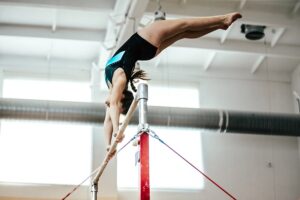Shoulder Injuries in Gymnastics
 Gymnastics require a combination of total body balance, flexibility, agility, strength, power, and endurance. The arms are crucial for executing almost all routines, highlighting the importance of having strong, flexible, and powerful shoulders to excel in any gymnastic movement.
Gymnastics require a combination of total body balance, flexibility, agility, strength, power, and endurance. The arms are crucial for executing almost all routines, highlighting the importance of having strong, flexible, and powerful shoulders to excel in any gymnastic movement.
In gymnastics, the shoulders endure supraphysiologic loads during various maneuvers. These loads routinely go beyond mere body weight bearing forces, as the rapid body movements typically amplify the combined shoulder joint reactive forces up to three times the body weight.
Approximately 30% of all competitive gymnasts have experienced shoulder ailments at some point in their careers. Of all those with shoulder ailments, around 30% of them have faced significant impairment or required surgery, preventing them from reaching their peak performance.
The rotator cuff muscles play a pivotal role in shoulder function and injury prevention. This group of four muscles assists the larger muscles in the shoulder, enabling various directional movements like raising or rotating the arm. Their primary function, however, is to ensure a tight connection between the top of the arm bone (the humeral head) and the shoulder blade bone (the scapula-glenoid), resulting in continuous compression of these bones during any arm motion, regardless of the direction. This compression, known as “glenohumeral joint compression,” keeps the shoulder joint centered and stable.
Maintaining this compressive effect is crucial for shoulder stability. However, when the load on the shoulder surpasses this compressive force due to weak rotator cuff muscles or lack of control, the shoulder joint may shift during motion, called micro-subluxation. This in turn leads to rotator cuff tendinitis, bursitis, labral tears, SLAP lesions, or even complete dislocation.
Aside from avoiding a direct fall on the shoulder, nearly all shoulder injuries can be minimized by developing strong and responsive rotator cuff muscles. Thus, it is essential for all gymnasts to be diligent in their rotator cuff conditioning exercises. While exercises like pulling rubber bands or lifting dumbbells help strengthen the directional movements of the shoulder, they do not target or enhance the primary function of providing glenohumeral joint compression.
The ShoulderSphere® technique utilizes tight and fast rotational movements to efficiently translate them into a powerful shoulder joint compression force. This is achieved by co-contraction of all four rotator cuff muscles simultaneously in all directions of shoulder motion. By smoothly spinning the internal ball at a fast pace, this technique effectively trains and strengthens all four rotator cuff muscles simultaneously as one functional unit. This enhances the coordination and responsiveness of the rotator cuff muscles to stay engaged in keeping the shoulder joint compressed, centered, and stable during rapid gymnastic shoulder directional changes.
Training both shoulders is crucial, since all gymnastics maneuvers demand the use of both shoulders to execute properly.
Using the Larger ShoulderSphere® A7 Model:
When spinning this 7 oz internal ball fast, keeping the Power Tracker in the “red zone” for a continuous 5-second duration while performing arm movements is akin to generating approximately 10 lb (4.5 kg) of rotator cuff force. Completing 10 repetitions would amount to a total of approximately 100 lb (45 kg) of force. An effective exercise routine for elite gymnasts would be 10 repetition movements and 3 sets for each arm (as demonstrated in the accompanying video).
The most effective way to train the rotator cuff muscles is by moving the arm across all planes of motion, simulating all the possible shoulder movement patterns required during gymnastic maneuvers. This comprehensive training approach enhances the responsiveness of the rotator cuff muscles, ensuring they stay engaged and adapt smoothly as the arm changes directions.
By being creative with arm movements and maintaining a disciplined rotator cuff strengthening program 2-3 times per week, shoulder injuries can be significantly reduced.